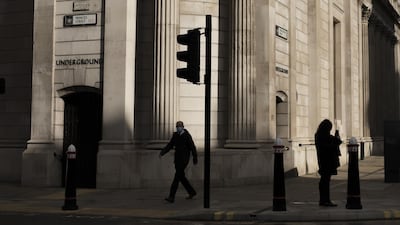The Bank of England injected a further £150 billion ($195bn) of stimulus into the UK economy on Thursday as it warned a second wave of the coronavirus pandemic will lead to a slower, bumpier recovery.
The BoE’s bigger-than-expected bond-buying programme - the fourth round of quantitative easing (QE) since March – takes the total stimulus to £895bn and comes as the lender also held its benchmark interest rate at a record low of 0.1 per cent.
“This extra QE is unlikely to be the last expansion. We think the Monetary Policy Committee will announce at least £100bn more QE in 2021, more than the consensus currently expects,” said Ruth Gregory, senior UK economist at Capital Economics.

Governor Andrew Bailey and his eight committee colleagues voted unanimously to increase the government bond-purchase target and keep the benchmark interest rate at the same level it has been since March. The corporate bond-buying target stayed at £20bn.
The stimulus – set to start in January and finish by the end of next year – will help to cushion Britain’s struggling economy as England starts a second lockdown to contain the rise of coronavirus cases.
Meanwhile, British finance minister Rishi Sunak told parliament on Thursday he was extending the country's coronavirus furlough scheme until the end of March. The job retention scheme will provide 80 per cent of the pay of temporarily laid-off workers up to a maximum of £2,500 a month, until the end of March. Mr Sunak said he would review the policy, which is being offered across the UK, in January.
This twin stimulus would continue an economic policy approach that won praise from the International Monetary Fund last month.
”It is important that we take prompt, strong and coordinated action,” Mr Bailey said on Thursday. “It’s an extraordinary situation, and it’s by no means over.”
The BoE slashed its estimates for economic growth, lowering the third-quarter forecast to 16.2 per cent from 18.3 per cent, and said it expects gross domestic product to fall by 11 per cent in 2020. It also expects a 2-per-cent contraction in the fourth quarter due to the second lockdown – a much lower estimate that economist expectations of 12 per cent.
This means the economy will shrink more this year than previously anticipated, the 2021 recovery will be slower and GDP will not return to its pre-crisis level until early 2022. However, a contraction of only 2 per cent in the fourth quarter diminishes the risk of a full-blown double dip recession.
The “recovery would take time, and the risks around the GDP projection were judged to be skewed to the downside,” the bank said.
Naeem Aslam, chief market analyst at Avatrade, said the BoE is "fighting two battles at the same time, which are lockdown and Brexit—a self-inflicted injury".
"The BoE has acknowledged the weakness in consumer confidence and spending, and to restore this, the bank has increased its asset purchase programme," he said. "The bank has also given a clear message that it is set to do more if the economy needs any further help. The fact that the bank has used the most famous phrase ‘whatever it takes’ shows that it is committed to do anything to restore growth."
Meanwhile, the BoE expects unemployment to climb to 7.7 per cent in the second quarter of next year with the risk of a “more persistent period of elevated unemployment”.
Britain's unemployment rate rose to 4.5 per cent in the three months to August, its highest in more than three years, with the number of redundancies increasing by 227,000.
This week, leading companies added to the UK's job crisis, with John Lewis slashing 1,500 jobs, on top of the 1,390 roles it had already shed during the pandemic, and Sainsbury's cutting 3,500 jobs.
Shoe retailer Clarks shoes has put the jobs of all 4,000 of its store staff on notice as part of its fight for survival, while US manufacturing firm Caterpillar said it is planning to cut 700 jobs at its Northern Ireland operations in Larne, County Antrim. UK lender Lloyds Bank said it was making 1,070 staff redundant on top of the 865 job losses earlier in the pandemic, while Marks & Spencer said earlier this week it had already cut 8,000 staff since March.
The BoE said the outlook for the economy “remains uncertain”.
“It depends on the evolution of the pandemic and measures taken to protect public health, as well as the nature of, and transition to, the new trading arrangements between the EU and the UK,” the regulator said.
Policymakers decided against cutting interest rates into negative territory for now, however a review of taking rates below zero is still underway and some analysts expect this decision early next year.
However, Ms Gregory expects the BoE to shun negative interest rates for the next six to 12 months and instead focus on expanding QE further by at least £100bn in 2021.
Meanwhile, with the MPC repeating the guidance that it won’t tighten policy “until there was clear evidence that significant progress was being made in eliminating spare capacity and achieving the 2 per cent inflation target”, Ms Gregory said she expected interest rates to be no higher than 0.10 per cent for the next five years.


